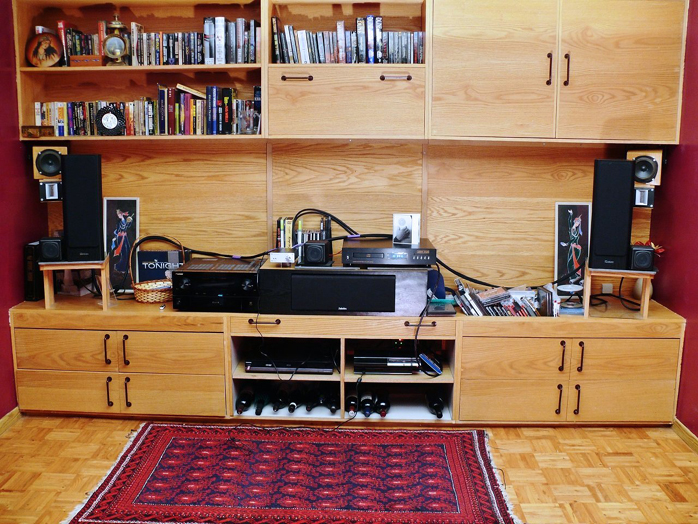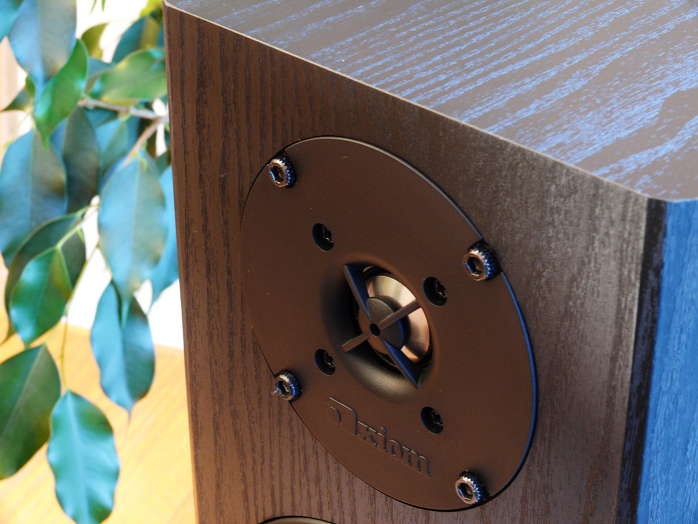This review page is supported in part by the sponsors whose ad banners are displayed below |
 |
 |
The LFR1100 was situated in the main listening room. Since this Axiom is intended as full-range contender, the subwoofer was unhooked. The Axiom DSP box sat between Tortuga LDR6 Pre and Bel Canto 200.4 configured for four channel operation. Cables were Madison Audio Lab to maintain my reference point. I did not take advantage of the LFR’s biwire option due to cable limitations. Let's assume superior performance from biwiring.
|

|
For the M22v3 I assembled the AudioSpace CDP 8 and Topping TP22 integrated with Audio Art SE cables. The little 22wpc amp had driven the fabulous $28'000/pr Casta Model C hornspeakers to disproportionate distraction. That marked it as a proven performer and ideal candidate for the budget Axiom in a lower power setting. Afterwards the M22s migrated into the big system with Paradigm Reference Servo 15 sub in a 2.1 channel affair to see how they would perform with major bass support and additional horsepower.
|
 |
|
|
|
|
 |
|
 |
A quick sampling of music that made the rounds. First, all the cuts from 2013 Grammy Nominees [Capitol 509999 79968 2 8]. That's a good cross section of popular music to act as a snapshot of talent, tastes and recording techniques. You will find gifted artists with minimal embellishment whose performances are faithfully captured and artists who under-perform but are over-engineered to compensate. It's a good bellwether to see where your musical priorities lie - bouncy fun or purist.
"What are you doing New Year’s Eve" from Terra Hazleton's Gimme Whatcha Got is classic sultry female jazz with subtle backup orchestra of piano, bass and trumpet on this cut. It's a clean warm recording that lets you melt back into a chair and enjoy. "Cantate Domino" from Star of Wonder [Reference Recordings RR-21CD] is a Keith O. Johnson number to display the San Francisco choral artists' full prowess in a lovely reverberant church for air, warmth, interplay and huge staging. A hallmark RR choice. |
|
"Xibalba" and "First Snow" from The Fountain [Nonesuch 79901-2] are from the Aronofsky film's soundtrack and a study in mystery and melancholia. The performers here are the audiophile Kronos Quartet staple and Mogwai. The music is dark, moody and intimate. Production quality is tasteful and subtly layered but dynamics are constrained. "You Drive me Crazy" from the HRx edition of From the Age of Swing [Reference Recordings HR-59] is a 24/176.4. version of a Dick Hyman and ensemble reading engineered by Keith O. Johnson for stunning gradation of dynamics, additional layers of spatial cues and a lovely nuanced performance. And yes there were more tunes from the cheerfully frolic to serious reference material but in deference to the reader, you want to know how the LFR1100 and M22v3 sounded. First let’s take a look at the M22v3.
|
 |
Straight out of the box the M22v3 was frightening in dynamic jump factor. Lowering the volume on the Topping TP22 to near zero did nothing to abate the situation. No ands ifs or buts, this little combo wanted to run. Shy or demure were not on the program. However out of the box the drivers also showed a need for some run-in. The obvious virtue of dynamic exuberance was coupled to an equally obvious skewed balance, with the tweeter having some overbite especially on axis and the bass lacking weight. Patience was rewarded. The engaging liveliness remained, highs and midrange sweetened considerably as driver outputs converged and the bass gained some much needed solidity and extension. Broken in the tonal balance was generally smooth—with the tweeter staying a little hot on axis—clean in the midrange and relatively lightweight in the bass. To put the bass in concrete terms, it was sufficient to recreate the body of a guitar with convincing weight but lost the dimensions and mass of a larger cello. Bear in mind that this setup was specifically assembled to assess standalone behavior. How did it perform in other departments? The M22 exhibited overt detail exaggeration out of the box but displayed increasing levels of subtlety and nuance as time wore on. Overall detail level was good, with the speaker losing some absolute resolution against pricier fare.
|
|
|
Soundstaging was extremely wide with good center fill. Depth was more in the studio monitor mold and a bit upfront as opposed to the cavernous audiophile perspective some may prefer. Reproduction of hall acoustics and air were fair though the speakers created the illusion of better due to some exaggeration of the titanium tweeter. Listening seat perspective for optimal imaging was somewhat restrictive in the horizontal plane but height was surprisingly forgiving if one discounts some minor tweeter dominance directly on axis.
|
 |
Performance strengths brought to mind the pairing of Bel Canto 200.4/Mike Tang Audio MTA F-60 Feastrex widebander. Yes the $11'000/pr Feastrex combo operated on an entirely higher plane with SOTA abilities on control, articulation and dynamic nuance but the $660 pairing of Axiom/Topping brought back fond memories by displaying a disproportionately healthy helping of those qualities. If it lacked ultimate levels of sophistication and refinement, it certainly made for a ridiculously inexpensive everyman reference on those points of character.
|
 |
When the M22s moved into the Tortuga/Bel Canto/Paradigm setup, the budget Axiom blossomed accordingly. The basic character remained but greater ancillary pedigree added layers of refinement and more dynamic muscle. The M22 retained its low-level articulation but more power translated as more peak range and higher achievable levels. Staging remained a bit forward but showed improved placement definition. On tonal balance and detail, the speakers transformed from budget feisty to upscale chic. Mids and highs were smoother, more sophisticated and of better cohesion to sound less overtly impressive and more neutral. The inherent absence of deep bass made for an easy marriage with the big sub.
|
 |
In its optimal 2.1 milieu the sat/sub system proved near seamless from top to newfound 14Hz bottom. Nuance combined with muscular kick. This was hardly budget performance. The combination paraded respectable imaging, smooth upper response, good dynamic life and a frequency range beyond that of most floorstanders. The M22s could be bettered in resolution, focus and transparency but they were not deficient in these areas. They simply played holistic strengths rather than an amalgamation of minor weaknesses. Where they had been a commendable standalone performer, they were a budget powerhouse with the right 0.1 support.
|
 |
So much for David. How about Goliath?
|
 |
  |
 |